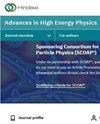辛量子力学中的分数有效夸克-夸克相互作用
IF 1.1
4区 物理与天体物理
Q3 PHYSICS, PARTICLES & FIELDS
引用次数: 2
摘要
考虑辛量子力学的形式,我们研究了一个描述束缚重夸克反夸克态的二维非相对论强相互作用系统。势有一个线性分量,在广义分数导数的背景下进行分析。为此,用线性势求解相空间中的薛定谔方程。通过介子c′的Wigner函数得到并分析了基态解。一个基本的结果是,分数量子相空间分析产生了夸克在介子中的约束,这与实验结果一致。本文章由计算机程序翻译,如有差异,请以英文原文为准。
Fractional Effective Quark-Antiquark Interaction in Symplectic Quantum Mechanics
Considering the formalism of symplectic quantum mechanics, we investigate a two-dimensional nonrelativistic strong interacting system, describing a bound heavy quark-antiquark state. The potential has a linear component that is analyzed in the context of generalized fractional derivatives. For this purpose, the Schrödinger equation in phase space is solved with the linear potential. The ground state solution is obtained and analyzed through the Wigner function for the meson
c
c
¯
. One basic and fundamental result is that the fractional quantum phase-space analysis gives rise to the confinement of quarks in the meson, consistent with experimental results.
求助全文
通过发布文献求助,成功后即可免费获取论文全文。
去求助
来源期刊

Advances in High Energy Physics
PHYSICS, PARTICLES & FIELDS-
CiteScore
3.40
自引率
5.90%
发文量
55
审稿时长
6-12 weeks
期刊介绍:
Advances in High Energy Physics publishes the results of theoretical and experimental research on the nature of, and interaction between, energy and matter. Considering both original research and focussed review articles, the journal welcomes submissions from small research groups and large consortia alike.
 求助内容:
求助内容: 应助结果提醒方式:
应助结果提醒方式:


